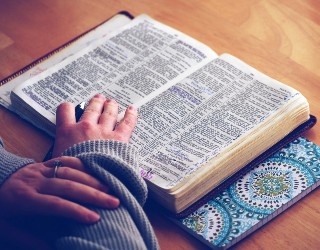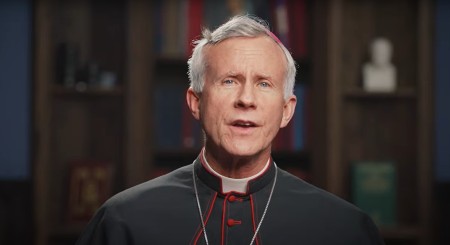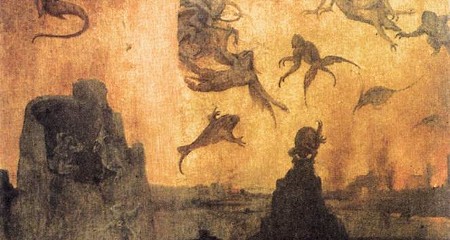Ancient Mass comes to Anchorage
FREE Catholic Classes
Anchorage, AK (The Anchor) - Ethereal chant, incense and perhaps even an ostrich-feathered liturgical fan will soon waft through Holy Family Cathedral in Anchorage.
Highlights
Catholic Anchor (www.catholicanchor.org)
11/18/2008 (1 decade ago)
Published in Living Faith
Beginning Dec. 6, the ancient Dominican rite Mass will be celebrated in Latin every first Saturday of the month at noon.
The successful emergence of the Dominican rite locally is keeping tradition alive, and perhaps fueling organic development of the liturgy into the future.
By early 2009, the Anchorage Archdiocese is also hoping to provide regular celebrations of the Tridentine Latin Mass, which was the standard Roman Catholic liturgy before the Second Vatican Council (1962-65).
A question of rites
Within the universal Catholic Church, there are 22 different rites, such as the Roman, Byzantine and Coptic, that incorporate different traditions into the Mass.
When it comes to forms of the Mass, "often we think of the Masses as 'pre-Vatican II' and 'post-Vatican II,' and it was more complicated than that," said Father Vincent Kelber -- a Dominican priest at Holy Family Cathedral, where he is preparing to celebrate the Dominican rite.
In 1570, the Council of Trent codified the Tridentine Mass as "the Mass for all time," he explained. It then served as the main form of the Mass for the Latin Church until the Second Vatican Council.
The Council of Trent, however, allowed for the celebration of those rites which, at the time, had been in existence for at least 200 years, Father Kelber said.
That meant the Dominican order and others like the Carthusians, Cistercians and Carmelites could continue celebrating their own rites, alongside the principal Tridentine Mass.
Father Kelber explained that by the 1200s, it was clear that the Dominicans needed a common liturgical expression for the order's many priests who preached and celebrated Mass in varied communities across Europe. Thus, the Dominican rite was established.
While the Tridentine Mass is sometimes criticized for being antiquated, it is actually pretty new compared to the medieval Dominican rite, noted Father Kelber. The Tridentine is really "the beginning of the modern era," he said.
At Vatican II, the Tridentine Mass was replaced by the "Novus Ordo" or "new Ordinary of the Mass" as the principal form of the Mass. In that form, which most Catholics are accustomed to today, prayers are said in the local language.
Ancient is new again
Those familiar with the Tridentine Mass will find similarities in the Dominican rite. Both are celebrated in Latin, which for centuries was the sacred liturgical language of the Catholic Church, Father Kelber said.
Additionally, in both the Tridentine and Dominican rites, priests face the same direction as the congregation -- toward the altar.
The point is to be "oriented towards the one God," said Father Kelber. The Eucharist is always central, he added.
Priests also wear special vestments in the Dominican rite, but since the Dominicans "pre-date lace," explained Father Kelber, they are not as ornate as those in the Tridentine rite.
Catholics may also notice that the Dominican rite contains many signs of reverence, such as bowing, Father Kelber explained.
A penitential prayer, which the priest leads at the start of the Mass, is said before he enters into the sanctuary, "the holy of holies," Father Kelber said. Also, communicants receive Communion kneeling.
"Every movement in the Mass is purposeful and prayerful; it is embodied worship," he said.
'Rite' for the times
While Vatican II ushered in many needed changes, the continued use of the Dominican rite helped provide stability amid the flux.
"We realize now and Pope Benedict realizes that some of the changes of the Second Vatican Council were good, but some of them were too fast, some weren't explained, some were poorly implemented and some weren't according to the documents," Father Kelber said.
The ancient Masses "helped people to cope," he added.
As part of the patrimony of the church, the ancient Mass is worth preserving, Father Kelber continued.
"It's okay to have this kind of diversity," he said.
Father Kelber said it is especially important to appreciate the "ethos" of a pre-reformation tradition, such as that of the Dominicans.
"There is a lot that the medieval times can offer," he said. "They weren't in the dark ages at all. They lived a life that we can see today is something worth emulating in many ways, because it was before the busy-ness of the modern world. They knew what contemplation was, they knew what silence was, and we don't."
An ancient rite blooms
In the 1980s interest in the Dominican rite grew among the young friars of the Dominicans' Western Province, said Father Kelber. Interest "bloomed again in a new way" with friars, such as Father Kelber, who were ordained in the late 1990s and early 21-century.
With no formal training on how to celebrate the ancient Mass, Father Kelber said he read about the Mass and worked with other priests familiar with it.
"Preservation work is personal," he said. "It has to be handed-down. It can't be just gotten out of a book."
Now, given the growing interest in the Dominican rite, the Western and Eastern Provinces of the Dominican order are planning instructive conferences for its friars. The first takes place August 2009 at St. Albert's priory in Oakland.
Here in Anchorage, with permission from his provincial director and Anchorage Archbishop Roger Schwietz, Father Kelber has been perfecting his practice of the Dominican rite on his days off.
"There are people all over the United States and the world excited about the old rite -- excited about Gregorian chant," he said. "It's not just one person here saying 'Well, I miss the old days.' It's not just something looking back, but something looking forward and a gift for these crazy times."
---
Republished by Catholic Online with permission of the Catholic Anchor (www.catholicanchor.org), official newspaper of the Archdiocese of Anchorage, Alaska.
Join the Movement
When you sign up below, you don't just join an email list - you're joining an entire movement for Free world class Catholic education.
-

-
Mysteries of the Rosary
-
St. Faustina Kowalska
-
Litany of the Blessed Virgin Mary
-
Saint of the Day for Wednesday, Oct 4th, 2023
-
Popular Saints
-
St. Francis of Assisi
-
Bible
-
Female / Women Saints
-
7 Morning Prayers you need to get your day started with God
-
Litany of the Blessed Virgin Mary
5 Biblical Warnings We All Must Heed
-

WHAT WILL IT TAKE? | Bishop Strickland Calls Out Silent Bishops in Strong Public Letter
-

Giants of the Fallen: Unveiling the Mystery of the Nephilim from a Catholic Perspective
-
Ancient Wisdom, Modern Choices: How Ecclesiastes 10:2 Illuminates Today's Political Divide
-
How Do We Know Truth? A Catholic Perspective
Daily Catholic
 Daily Readings for Monday, November 18, 2024
Daily Readings for Monday, November 18, 2024 St. Rose Philippine Duchesne: Saint of the Day for Monday, November 18, 2024
St. Rose Philippine Duchesne: Saint of the Day for Monday, November 18, 2024 Bless Me, Heavenly Father.: Prayer of the Day for Monday, November 18, 2024
Bless Me, Heavenly Father.: Prayer of the Day for Monday, November 18, 2024- Daily Readings for Sunday, November 17, 2024
- St. Elizabeth of Hungary: Saint of the Day for Sunday, November 17, 2024
- Prayer to Saint Anthony of Padua, Performer of Miracles: Prayer of the Day for Sunday, November 17, 2024
![]()
Copyright 2024 Catholic Online. All materials contained on this site, whether written, audible or visual are the exclusive property of Catholic Online and are protected under U.S. and International copyright laws, © Copyright 2024 Catholic Online. Any unauthorized use, without prior written consent of Catholic Online is strictly forbidden and prohibited.
Catholic Online is a Project of Your Catholic Voice Foundation, a Not-for-Profit Corporation. Your Catholic Voice Foundation has been granted a recognition of tax exemption under Section 501(c)(3) of the Internal Revenue Code. Federal Tax Identification Number: 81-0596847. Your gift is tax-deductible as allowed by law.







 Daily Readings for Monday, November 18, 2024
Daily Readings for Monday, November 18, 2024 St. Rose Philippine Duchesne: Saint of the Day for Monday, November 18, 2024
St. Rose Philippine Duchesne: Saint of the Day for Monday, November 18, 2024 Bless Me, Heavenly Father.: Prayer of the Day for Monday, November 18, 2024
Bless Me, Heavenly Father.: Prayer of the Day for Monday, November 18, 2024

